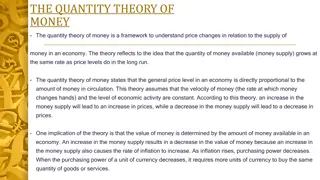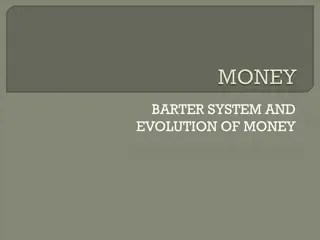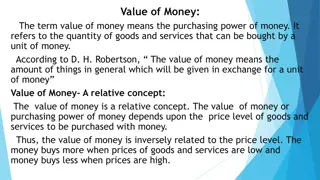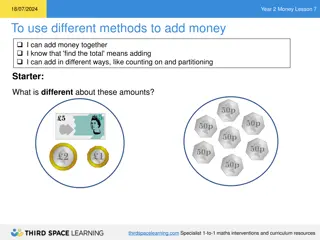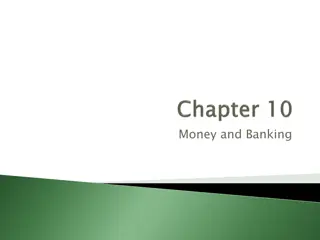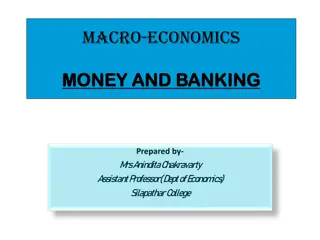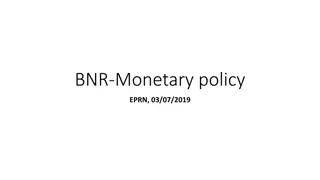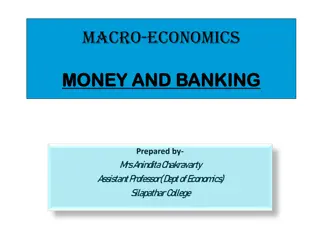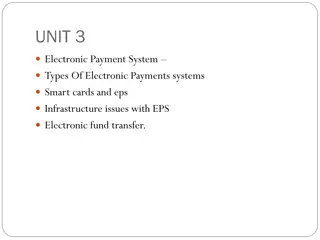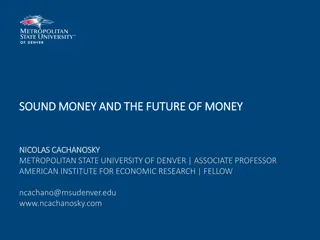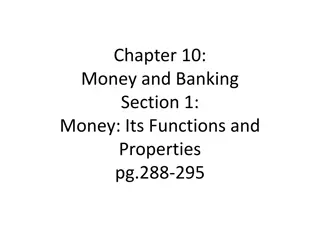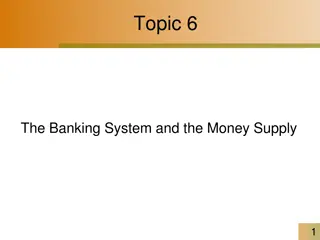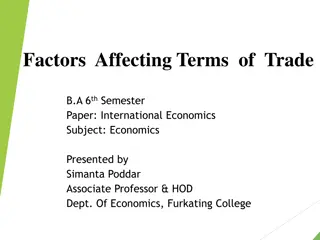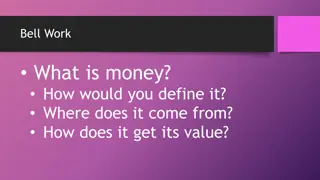Understanding Barter System and Money: Definitions and Functions
Barter system involves direct exchange of commodities without money, facing challenges like lack of common measure of value and divisibility. Money, derived from Latin "Moneta," serves as a medium of exchange, measure of value, and store of wealth, enabling economic transactions and facilitating borrowing and lending.
Download Presentation

Please find below an Image/Link to download the presentation.
The content on the website is provided AS IS for your information and personal use only. It may not be sold, licensed, or shared on other websites without obtaining consent from the author. Download presentation by click this link. If you encounter any issues during the download, it is possible that the publisher has removed the file from their server.
E N D
Presentation Transcript
Barter System: The direct exchange of one commodity for another commodity without the use of money is known as barter system. Difficulties of Barter system: Lack of double coincidence wants. Lack of common measure of value. Lack of divisibility. Lack of store of value. Problem of borrowing and lending. Difficult in the case of services. Lack of transfer of value. 1. 2. 3. 4. 5. 6. 7.
Definitions of Money. The word Money is derived from the Latin word Moneta which means Roman Goddess. D.H. Robertson defines money as anything which is widely accepted in payment for goods or in discharge of other kinds of business obligations . Crowther defines money as anything that is generally acceptable as means of exchange and at the same time acts as measure and store of value F A Walker defines money is what money does
Functions of Money: A. Primary Functions: 1. Medium of Exchange: Money serve as medium of exchange or medium of payments. Money is used as a medium through which people exchange their goods and services. It facilitates buying and selling of goods and services 2. Measure of Value: Money is used in measuring the value of different kinds of goods and services. With the help of money, it is easy to compare the relative values of commodities and services. The value of all goods and services is expressed in terms of money is called price.
B. Secondary Functions: 1. Standard of Deferred Payments: In a money economy, we can buy goods and services without making immediate payments. Payments could be made at a future date. Money is very useful for lending and borrowing. Money enables traders to deal on credit basis. 2. Store of Value: Goods cannot be stored for a long time. Hence, money helps to store the surplus income or wealth in the form of money for long duration. Thus, it enables savings and capital formation takes place.
3. Transfer of value: Money facilitates the transfer of the value of anything from one place to another and from one person to another. Since money possesses the quality of general acceptability, a person can sell his property or assets at one place and buy new property or assets at another place. C. Contingent Functions: 1. Distribution of national Income: Money helps in measuring the contribution of various factors of production and thus facilitates the distribution of income. Rewards of each factors of production in the form of wages, rent, interest and profit are determined and paid in terms of money.
2. Maximisation of Satisfaction. Money helps consumer and producer to maximise their satisfaction. It is only through proper allocation of income that consumer can equalize satisfaction from expenditure on different goods. With the help of money, producers can eqalise the factor prices on the basis of marginal productivity of factors. 3. Basis of Credit: Modern economy is based on credit system. The credit structure depends entirely upon the base of money. The volume and supply of credit is linked with the volume and supply.
4. Imparts liquidity and Uniformity to wealth. All forms wealth of can be converted into money. Thus, money gives liquidity to various forms of wealth. Hence money imparts uniformity to wealth. ************************
Classification of Money 1.On the basis of Nature: J. M. Keynes has classified money into two kinds. a. Actual Money. It is the money which circulates as a medium of exchange. This money is used to buy and sell goods and services. For example, in India rupee constitutes actual money. b. Money of Account. It is the form of money in which the accounts are maintained and the value is measured. Thus, money on account is the description or title. For example, rupee in India, dollar in USA etc.
2. On the basis of Legality: a. Legal tender Money. It is the money which the government puts into circulation by law. The people are bound to accept it as the means of payment and in discharge of debts Legal tender money is of two types. Limited legal tender money. Unlimited legal tender money. b. Optional money or Non legal tender money. Money which is generally accepted by the people, but has no legal authority behind it, is known as non legal tender or optional money. Various credit instruments like cheque, drafts, promissory notes, bills of exchange etc. are the form of non legal tender money. It is also known as credit money or bank money. i. ii.
3. On the Basis of Commodity: a. Metallic Money: Money made of metals is called metallic money. Metals used to make money are gold, silver, copper, nickel etc. Metallic money is of two types. Standard Money: It is the money whose face value and the intrinsic value are the same. Face value refers to the official value expressed on the coins and intrinsic value means the value of the metal contained in the coins. Standard money is generally made of precious metals like gold & silver. It is does not exist today i.
ii. Token money : Token Money is that type of metallic money whose face value is greater them its intrinsic value. These are the coins made up of cheaper metals like nickel, aluminium. Token money consists of all coins that are in circulation . They are generally limited legal tender. b. Paper Money: Paper money is the money made of paper. It consists of currency notes issued by the govt or the central bank of a country. It includes 2 types, They are,
i. Representative Paper Money : Representative paper money is fully backed up by metallic reserve . Under this type of paper money , gold or silver equivalent to the exact value of paper notes were kept in the reserve by legal monetary authority. ii. Convertible Paper Money: Convertible paper money is not backed by hundred percent metallic content, but can be converted into gold or silver as per the legal laws. The value of the metallic reserve will be less than the value of the notes issued .
iii. Inconvertible Paper Money: Inconvertible paper money cannot be converted Into standard coins. It will be issued only to a limited extent . No metallic reserves are kept behind the issue of inconvertible paper notes. 4. On the basis liquidity: On the basis of liquidity money can be classified as Actual money & Near Money. a. Actual money: Actual Money is the money in circulation. It consist of the currency notes , coins and demand deposits. Of which coins and notes are perfectly liquid . Whereas demand deposit or bank money in the form of cheque or draft are considered highly liquid.
b. Near Money : Near money refer to all these financial assets which possess many of the characteristics of money and can be converted into money without loss of nominal value . It consists of time and saving deposits with banks , bills of exchange , treasury bills, shares of joint stock companies etc. ************ ************* ***********
Near-Money: Near Money refers to all those financial assets Which possess many of the characteristics of money and can be converted into money without loss of nominal value. It does not command cent percent liquidity as in the case of actual money. Near money is put into circulation by banks, finance companies and other institutions. All such assets have the quality of money as store of value, but they can not be used as a medium of exchange. Some of the financial assets which are considered as near money as follows: Drafts and Bills of exchange 5. Fixed and saving Deposits. 1. Treasury bills 6. Saving Certificates. Bonds Equity Shares 2. 3. 4.
Distinctions between Money and Near Money: 1. Money consists of currency notes, coins and bank deposits of the banks Near money, on the other hand, includes the financial assets like time deposits, bills of exchange, bonds, shares, etc. 2. Money possesses 100 percent liquidity; it is perfectly liquid or used as a means of payment. Near money lacks 100 percent liquidity. It involves time cost for its conversion into money.
3. Money acts as a unit of account or common measure of value. All prices are expressed in terms of money. On the other hand Near Money does not perform such functions and its value is expressed in terms of money. 4. Money is directly used for making transactions. On other hand, Near money has to be converted in to money then used for transactions. 5. Money is not an income yielding asset. But Near money assets are income yielding.
Demand for Money: The demand for money refers to the desire to hold cash. It is also referred as liquidity preference. Money can be used for any purpose immediately and hence people desire to hold money either as cash or in the form of readily withdrawable demand deposits in banks. Demand for money arises from the important functions of money, such as medium of exchange and measure of value. According to the classical view, the demand for money in a country depends up on the supply of goods and services available. The larger the supply of exchangeable goods and services, the greater is the demand for money. This concept of demand for money is known as the transactions or medium of exchange The Modern economists emphasize the store of value function of money. According to them, the demand for money means the demand to hold money or cash balance.
Determinants of the Demand for Money: The demand for money is affected by several factors like the level of income, interest rates, and technological changes, etc. J M Keynes in his The General theory of employment, Interest and money identified three motives for holding money, they are 1. Transaction Demand for Money: It means the money we need to purchase goods and services in day to day life. The people will keep certain stock of money to enable them to carry out their transactions. It includes a) the business motive b) the income motive.
2. Precautionary demand for Money: it means the money we may need for unexpected purchases or emergencies. Unexpected expenses such as medical bills, unemployment, accident repair bills etc. 3. Speculative Demand for Money: The speculative motive implies the desire of the public to keep a certain amount of cash to make speculative gains out of the purchase and sale of securities ( bonds and equities) through future changes in the rate of interest. Milton Friedman in his The Quantity theory of money, specified the following determinants of demand for money. They are total wealth, the division of wealth between human and non human forms, they expected rates of return on money and other asset and other variables
Thus, three motives, namely, transactions, precautionary and speculative motives that influence the demand for money in the community. ****************
The supply of Money: The term supply of money means the aggregate stock of domestic money held by the public in a country. The term public refers here to the private people, business firms, etc. operating in the country, but it excludes the central government, the central bank and the commercial banks. The total money supply in a country comprises i)currency money issued by the Central bank or the central government. ii)demand deposits held by the public with the commercial banks.
Concepts of Money Supply: Since April 1977, RBI has adopted four alternative definitions of money supply, They are M1,M2,M3,M4, 1. Money supply(M1) or Narrow Money: M1 consists of i] Currency with the public which includes notes and coins ii] Demand deposits with commercial and co-operative banks, excluding inter-bank deposits, and iii) Other deposits with RBI which include current deposits of foreign central banks, financial institutions and quasi financial institutions. M1=C+DD+OD 2. Money Supply (M2): M2 is a broader concept of money supply. In addition to M1 the concept of money supply include saving deposits with post office.
3. Money Supply (M3): M3 is a broader concept, It consists of M1,plus time deposits with the commercial banks and co-operative banks. M3=MI +time deposits with the banks. 4. Money supply (M4): The money supply M4 consists of M3, plus total deposits of the post office. This is the broadest measure of the money supply. M4=m3+total deposits with post office.
Determinants of Money Supply: 1. Monetary Base: Magnitude of monetary base is a important determinant of the size of money supply. Monetary base refers to the group of assets which empowers the central bank to issue currency from time to time. The monetary base includes monetary gold stock, reserve assets ( government securities, bonds and bullion etc with the central bank) 2. Public Desire to hold Currency and Deposits: People s desire to hold cash and demand deposits in banks also determines the money supply. If people are in the habit of keeping less in cash and more in deposits with the commercial banks, the money supply will be large. Because, It helps the banks to create more money with larger deposits.
3. Cash Reserve Ratio: Cash reserve ratio is also an important determinant of the money supply. An increase in the required reserve ratio reduces the supply of money and a decrease in required reserve ratio increases the money supply. 4. Government s budgetary policy: A budget deficit is an important source of expansion of money supply in the economy. When the government expenditure exceeds public revenue, the fiscal gap is filled by either by public borrowing or borrowing from the central bank. It leads to increase in money supply.
5. Currency Ratio: Currency ratio ( c ) is the ratio of currency demand to the demand deposits. As long as the r ratio is less than unity, and an increase in the c ratio, must reduce the multiplier. Symbolically, C=C/DD Where c is the public s demand for currency and DD is demand deposits. 6. Time-Deposit Ratio. ( t ) It is the ratio of time deposits to the demand deposits. It has a negative effect on the money muliplier (m). A rise in t reduces m and thereby the supply of money decreases. 7. Value of Money: The value of money ( 1/p] is measured in terms of other goods and services. It has a positive influence on the monetary base ( B ) and thus influences the money stock.
8. Real Income: Real income has a positive influence on the money multiplier which again influences the money supply. An increase in real income tends to increase the money multiplier and thus increases the money supply. 9. Interest Rate: The money multiplier is also influenced by the interest rate which again influences the money supply. An increase in the interest rate will reduce the reserve ratio, which increases the money multiplier and hence increase the money supply. 10. Monetary Policy: The money multiplier is influenced by the monetary policy of the country which again Influences the money supply. An increase in the reserve ratio will reduce the money multiplier and thus reduce the money supply. A decrease in the reserve ratio will increase the money multiplier and thus increase the money supply.
High powered money (H) or Reserved money : High powered money or powerful money refer to the money produced by monetary authority of a country . It is the sum of commercial bank reserves and currency notes and coins held by the public. Following are the important component which determine high power money 1. Currency with the public 2. Other deposits with central bank of the country 3. Cash with banks 4. Banker deposits with the central bank of the country Thus , high power money: H= C+RR+ER Where, C represents the currency RR the required reserve and ER is the excess reserves
Sources of High Powered Money 1. Claims of Reserve Bank of India. Reserve Bank also provides loans to the government. This loan is in the form of investment in government securities by the Reserve bank. It is also a source of High powered money. 2. Net Foreign Exchange Assets of the Reserve Bank: When Reserve Bank purchases Foreign securities by paying the money of the country, then the quantity of foreign exchange increases which in turn increase high powered money. 3.Government's Currency Liabilities to the Public. Finance Ministry of the Indian Government is responsible for printing one rupee note and also for coinage. Thus the quantity of high powered money will also increase. 4. Net Non- Monetary liabilities of Reserve Bank: It is in the form of capital introduced in the national fund and statutory fund. Its main items are Paid up capital, Reserve Fund, Provided fund and Pension fund of the employees of the RBI. It is inversely proportional to high powered money.
Money Multiplier: It is the ratios of commercial bank money to central bank money. It relates to the maximum amount of commercial bank money that can be created, given a certain amount of central bank money. The money multiplier describes how an initial deposit leads to a greater increase in the total money supply. It is the ratio of decrease or increase in the money supply in relation to the decrease or increase in deposits. Money multiplier = Change in total money supply change in the monetary base. Money multiplier is the amount of money generated by the banking system with a certain amount of their reserves. ( say 10% or ten rupees) The amount of money generated here is determined by the reserve ratio. Money Multiplier=1 R Thus, It is clear that, a higher reserve ratio means a lower money multiplier and a lower reserve ratio means a higher money multiplier.
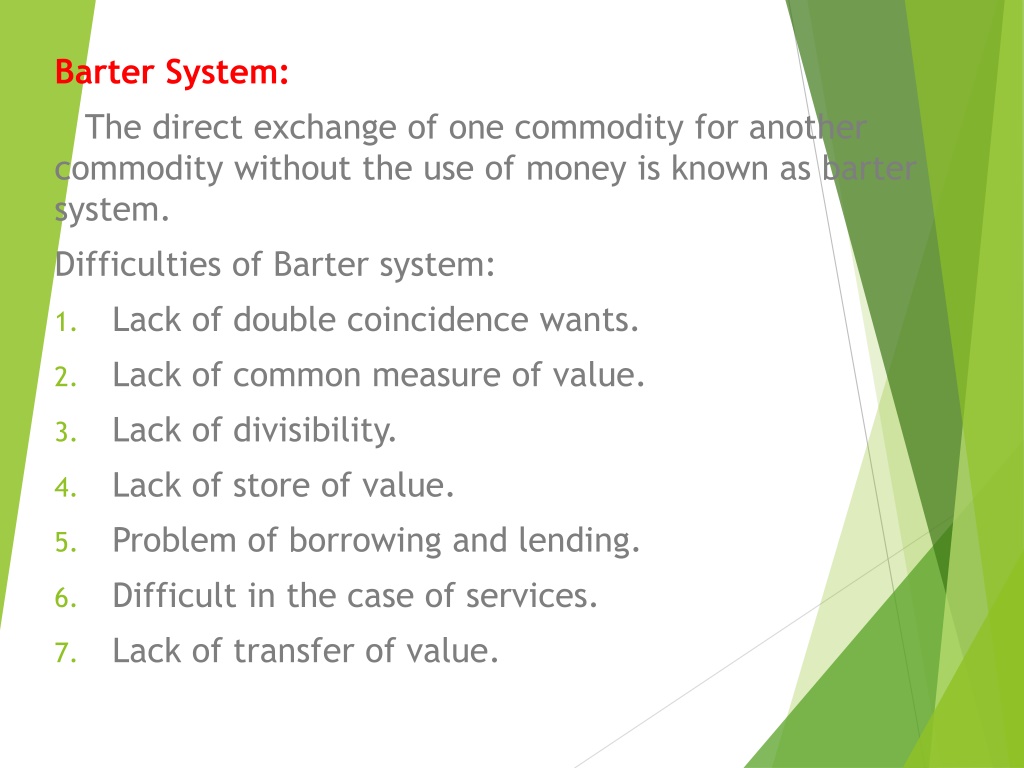
 undefined
undefined

